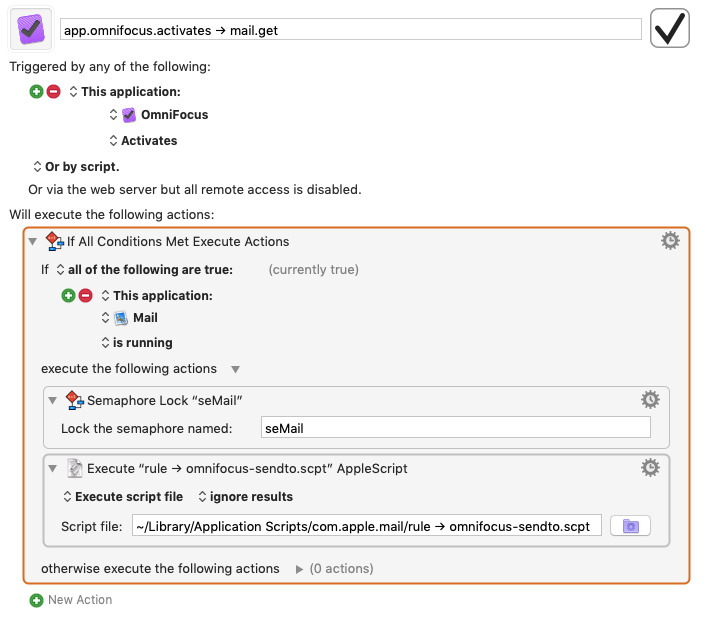

I respond much better when this sort of data is represented in a visual format than in the list-centric perspective OmniFocus gives me. I can immediately see where I should be focusing my energy, and it gives me a good idea of how many ways I’m splitting myself right now. Active projects are further sub-divided: for example, projects whose first available task has the context “Waiting for” are greyed out, since I can’t do anything about them right now. Using this data I can pretty easily divide my projects into the above to do/doing/done categories. I categorize my projects based on their current status (on hold/active/completed/dropped) as well as their tasks. OmniFocus’ Scripting Bridge support makes it very easy to export data. These “sticky notes” can be further subdivided by area or responsibility, to make the whole system as complex or simple as required. A simple kanban board consists of projects organized into columns such as “To do”, “Doing”, and “Done”. Over the last year or so I’ve become interested in personal kanban for project organisation, especially at this big-picture level. While OF is a great tool, I feel its list-based view falls short at the “big picture” level. I also have a couple of Objective-C/Cocoa scripts that run periodically on my computer to pull data out of OmniFocus for display in other environments. I’ve already described my File Tasks script, but a number of repeating tasks (especially more complex projects with shifting start and due dates) rely on Chris Sauve’s incredible Templates.scpt, which you should definitely check out. I end up using a couple of AppleScripts and associated tools to automate segments of my workflow. The main trick here is to make sure that I don’t flag too many items every day: it’s easy to overestimate exactly how much I can get accomplished in an afternoon, finish one of the four assigned tasks by 5pm, and feel terrible for the evening.
#Omnifocus 3 scripts series#
By switching to a “flagged-and-due” perspective I can narrow my focus down to a series of well-defined tasks for the day, which again removes all of that extraneous cruft from around the edges of my task list. At the start of the day I’ll review all my active projects and, based on current goals, flag a series of tasks (usually no more than 3-4). On the right, a typical perspective setup.Ī big motivator for me comes from Leo Babuta’s Zen To Done. My OmniFocus Perspectives palette in Keyboard Maestro. Rather than clutter my OmniFocus toolbar or try to remember everything, I have a palette in KeyboardMaestro devoted to my OF perspectives: hitting F1 reveals every perspective I use, along with appropriate keyboard shortcuts. To combat this I’ve been ruthlessly narrowing my perspectives, only allowing in those contexts that I can definitely act on.

I’ve recently found that I get distracted and off-task even if I have only one or two tasks visible in OmniFocus that I can’t do. My main work environments are modelled by perspectives, which limit visible contexts. The process of doing happens in the context view. The number of projects and folders I have in OmniFocus (especially counting maintenance projects and recurring tasks) is generally a good deal longer than my screen height, so I’m slowly developing a script that will move projects and task groups from the Inbox to any point in my project hierarchy. Most projects ended up being classified as either Home or Work, with each area further broken down depending on the area of responsibility. Organisation is something that I still struggle to get exactly right.

I have a recurring task to ensure that I regularly transfer tasks from my notebook to OmniFocus so these tasks don’t fall between the cracks. Away from it, I either write them down or put them into OmniFocus on my iPhone. When I’m at the computer, I use Quick Entry to capture random thoughts. My OmniFocus activity revolves around three activities: capture, organisation, and doing.Ĭapture is the most boring step. In my spare time I’m somewhat enthusiastically involved in roleplaying and story-gaming, as well as keeping up a hobby of coding in ruby and Cocoa/Objective-C (which I document on my blog.) I got interested in Getting Things Done during my Honours year (2008), and I haven’t looked back. graduate from the University of Canterbury, New Zealand. More details on the script information page.My name is Jan-Yves Ruzicka and I’m a recent Chemistry Ph.D.
#Omnifocus 3 scripts update#
** Follow on Twitter, Facebook, Google Plus, and ADN for Update Notices! **
#Omnifocus 3 scripts generator#
OmniFocus - Weekly Project Report Generator


 0 kommentar(er)
0 kommentar(er)
